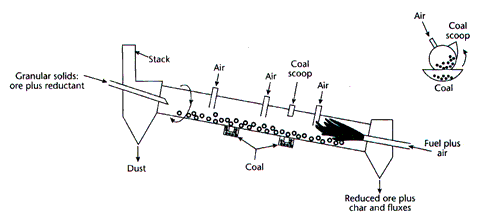PROCESS OPTIONS
Technology trials
Modern techniques for dealing with titanium-containing ores had been developed in Germany, Norway and Japan in the 1960s. In order to counter the high-energy costs of electric smelting, the ores were pre-heated and pre-reduced in rotary kilns. In Japan, a number of small companies had reduced concentrates very similar to New Zealand ironsands in such kilns, cooled, and then melted them in submerged-arc, pig-iron furnaces. However the electricity consumption was high and problems occurred with accretions in the kiln, giving a phenomenon known as ringing. Furthermore, the Japanese used coke breeze* or anthracite in their kilns, rather than sub-bituminous coal. Nevertheless, since New Zealand planners were still convinced of the importance of overseas research, Dick and Marshall were sent to study the Japanese processes as further preparation for the development of and New Zealand industry.
Back to Saga
Rotary Kilns
Rotary kilns are used widely in thermal processing of solids as in cement production, calcining and reduction of metal ores.
They are essentially refractory-lined steel tubes, typically of one to four metres internal diameter and 30 to 100 metres in length, mounted at a slight slope (in the range of 1 – 6%) and rotated slowly (0.5 to two revolutions per minute) by drive motors.
Granular solids (iron ore and carbon in the case of iron reduction), fed through seals at the upper end of the kiln, travel slowly down the slope in a spiral, tumbling path to the lower end where they are discharged, again through seals and via coolers if necessary.
The kiln is fired by fuel and air, usually injected at the lower end. The flame travels up the kiln, counter to the solids, heating them directly by radiation and indirectly through the refractory lining, with the tumbling motion promoting effective heat transfer. In many cases mechanical arrangements permit injection of air, solid fuels and reactants through the kiln walls.
Gases are discharged from the upper end through coolers and cleaners to exhaust stacks.

Apart from an occasional mechanical and refractory problem, the main difficulty in kiln operation arises from the solids (fly ash from coal mixed with fine ore abraded from the tumbling charge) entrained in the hot kiln gases, sticking to the refractory lining.
At the hottest parts of the kiln these gradually build up accretions or rings, which sometimes spall off to form large balls that block the kiln. Ironically, artificial rings, called dams, are sometimes built inside the kiln to slow the flow of solids.
* Coke breeze is fine material screened out of coke and used in blast furnaces.
Back to Saga

